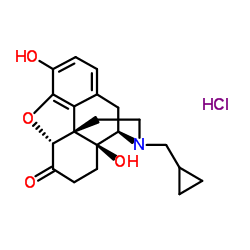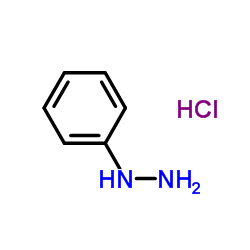Naltrindole hydrochloride

Naltrindole hydrochloride structure
|
Common Name | Naltrindole hydrochloride | ||
|---|---|---|---|---|
| CAS Number | 111469-81-9 | Molecular Weight | 450.95700 | |
| Density | N/A | Boiling Point | 664.2ºC at 760mmHg | |
| Molecular Formula | C26H27ClN2O3 | Melting Point | N/A | |
| MSDS | Chinese USA | Flash Point | 355.5ºC | |
Use of Naltrindole hydrochlorideNaltrindole hydrochloride is a highly potent and selective non-peptide δ opioid receptor antagonist with a Ki of 0.02 nM. |
| Name | Naltrindole hydrochloride |
|---|---|
| Synonym | More Synonyms |
| Description | Naltrindole hydrochloride is a highly potent and selective non-peptide δ opioid receptor antagonist with a Ki of 0.02 nM. |
|---|---|
| Related Catalog | |
| Target |
Ki: 0.02 nM (δ opioid), 64 nM (μ opioid), 66 nM (κ opioid)[1] |
| In Vitro | Opioid drugs exert a wide spectrum of physiological and behavioral effects. These effects are mediated via membrane-bound receptors, of which the best characterized are the kappa, delta, and mu receptors[1]. Naltrindole inhibits the proliferation of cultured human U266 MM cells in a time- and dose-dependent manner with an EC50 of 16 μM. Treatment of U266 cells with naltrindole significantly decreases the level of the active, phosphorylated form of the kinases, extracellular signal-regulated kinase and Akt, which may be related to its antiproliferative activity[2]. Naltrindole inhibits growth and induces apoptosis in the three characteristic SCLC cell lines, NCI-H69, NCI-H345, and NCI-H510. Naltrindole treatment reduces constitutive phosphorylation of Akt/PKB on serine 473 and threonine 308 in cells and also its downstream effectors glycogen synthase kinase-3β and the Forkhead transcription factors AFX and FKHR[3]. |
| In Vivo | Naltrindole significantly decreases tumor cell volumes in human MM cell xenografts in severe combined immunodeficient mice[2]. In mice, naltrindole at 20 mg/kg s.c. antagonizes the δ-selective agonist effect of [D- Ser, Leu, Thr]enkephalin (DSLET) without blocking the antinociceptive effect of morphine or U50488H. Naltrindole is the only highly selective δ antagonist that is active upon peripheral administration[4]. Acute naltrindole induces significant decreases in external and total ambulation (horizontal activity) and rearing behaviour (vertical activity), as well as a significant increase in grooming frequency. In animals chronically treated with naltrindole there is an increase in total ambulation one day after the discontinuation of the treatment[5]. |
| Cell Assay | U266 cells are plated in 96-well plates at 2000 cells per well in 100 μL of RPMI 1640 medium, supplemented with 10% fetal bovine serum, 100 U/mL penicillin, and 100 μg/mL streptomycin sulfate. Cells are incubated in quadruplicate in the presence of the various antineoplastic agents to construct dose-response curves, alone or in combination with various doses of naltrindole. At the end of the incubation 10 μL of WST-1 cell proliferation reagent is added to each well, and the plates are returned to the incubator for 1 h. Absorbance is then measured[2]. |
| Animal Admin | Rats: Effects of neonatal naltrindole treatments on open field activity is tested in 20-day old rats. The animals are injected chronically with saline or naltrindole (1 mg/kg, s.c.) (from birth to day 19), and 1 day after the discontinuation of this treatment are studied for the acute effects of naltrindole (1 mg/kg, i.p.)[5]. Mice: Naltrindole is dissolved in distilled water to make a 3 mg/mL solution, and mice are injected with 10 mL/kg daily. Human RPMI 8226 multiple myeloma cells are inoculated subcutaneously into both flanks of SCID mice (10 million cells per flank). After 8 days, 12 mice are divided into two groups of six mice each: vehicle-injected and naltrindole-injected (30 mg/kg). Animals are dosed daily for 36 days, and body weights and xenograft tumors are measured twice a week with a digital caliper[2]. |
| References |
| Boiling Point | 664.2ºC at 760mmHg |
|---|---|
| Molecular Formula | C26H27ClN2O3 |
| Molecular Weight | 450.95700 |
| Flash Point | 355.5ºC |
| Exact Mass | 450.17100 |
| PSA | 68.72000 |
| LogP | 4.31250 |
| Vapour Pressure | 1.51E-18mmHg at 25°C |
| InChIKey | KNJKRQXCFJCQHC-UZEHISEMSA-N |
| SMILES | Cl.Oc1ccc2c3c1OC1c4[nH]c5ccccc5c4CC4(O)C(C2)N(CC2CC2)CCC314 |
| Storage condition | 2-8℃ |
| Personal Protective Equipment | Eyeshields;Gloves;type N95 (US);type P1 (EN143) respirator filter |
|---|---|
| RIDADR | NONH for all modes of transport |
| WGK Germany | 3 |
|
~91% 
Naltrindole hyd... CAS#:111469-81-9 |
| Literature: Duval, Romain A.; Lever, John R. Green Chemistry, 2010 , vol. 12, # 2 p. 304 - 309 |
| Precursor 2 | |
|---|---|
| DownStream 0 | |
|
Naltrindole, a highly selective and potent non-peptide delta opioid receptor antagonist.
Eur. J. Pharmacol. 146 , 185, (1988)
|
|
|
Acute delta-opioid receptor activation induces CREB phosphorylation in NG108-15 cells.
Eur. J. Pharmacol. 390 , 1-6, (2000) A growing body of evidence supports an important role of the transcription factor cAMP responsive element binding protein (CREB) in mediating opioid-induced changes in the cAMP pathway. Regulation of ... |
|
|
Characterization of delta-opioid receptors and effect of enkephalins on IRD 98 rat epithelial intestinal cell line.
Pflugers Arch. 439 , 547-554, (2000) Using 3H-Tyr-D-Ala-Gly-Phe-D-Leu-OH (3H-DADLE) as a radioligand, delta-opioid binding sites on the IRD 98 rat epithelial cell line were identified. These sites were found to be reversible, saturable, ... |
| MFCD00069313 |
| NTI |
| NTI hydrochloride |
| Naltrindole (hydrochloride) |

